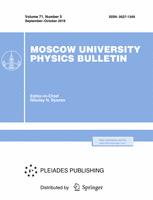Annotation
The analysis of the experimental data from the ShAL MSU (ShAL is the Russian contraction for extensive air shower, or EAS, and MSU stands for Moscow State University) facility is used to estimate the mass composition of primary cosmic rays (PCR). The QGSJET quark-gluon model of hadronic interactions is used in the calculations, and it is assumed that the knee in the primary energy spectrum is the consequence of primary-cosmic-ray diffusion. The model used in the calculations provides a fairly good reproduction of the primary energy spectrum recorded at the ShAL MSU and ShAL Tunka-25 facilities. We also discuss the experimental spectra in the electron and muon numbers recorded at the KASCADE facility.
© 2016 Publisher M.V.Lomonosov Moscow State University
Authors
E.A. Vishnevskaya, V.N. Kalmykov, N.N. Kalmykov, G.V. Kulikov, V P. Sulakov
Institute of Nuclear Physics, Moscow State University, Leninskie Gory, Moscow, 119992, Russia
Institute of Nuclear Physics, Moscow State University, Leninskie Gory, Moscow, 119992, Russia



